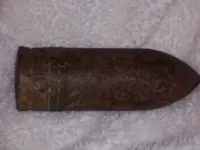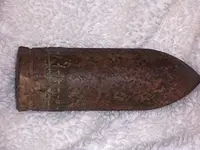sthrngold07
Jr. Member
To tell you a lil story in behind this.I was probably 10yrs old and was guiding an old hand plow behind my Papa which was on the tractor when we hit something hard,he got off the tractor to get it(which he though was a big rock) and this is what he came up outta the dirt with.He had put it up from me thinking it was a mortar head and may not've been fired yet.He passed away in Nov.,but a coupla yrs ago when we went to the nursing home to see him,I asked if he could still remember where he'd put it,if was even still there,OF COurse he knew,he had sucha awesome mind and memory.Anyway he told me exactly where he had hidden it,so now I have it with me and plan on making a display for it,one for it always keeping me in suspense what it was and the main reason is for how much I loved him and respected him!OK.....sorry for that short long story,but I will say that we know the Civil War came through this way and I'm thinking maybe a Parrot Shell or something,but I'd like to fin out what is for sure though.They lived up on a pretty big hill and was where it was found,it weighs appr. 6 1/4lbs.,the base is 2 1/8" wide,and it's 6 5/8" long,Also the grayish looking 'ring' that you see near the bottom seems to be brass maybe copper ....hope this helped.PLEASE,someone know what this is!  Thanks for ANY opinions,guesses,info,help,and or whatever you can give me!
Thanks for ANY opinions,guesses,info,help,and or whatever you can give me!
 Thanks for ANY opinions,guesses,info,help,and or whatever you can give me!
Thanks for ANY opinions,guesses,info,help,and or whatever you can give me!














